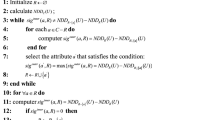Abstract
Attribute reduction is one of the research hotspots in the field of data mining. Although the result of attribute reduction algorithm based on single attribute identification matrix is better, it is still not efficient enough to deal with large-scale information system problems. In this paper, the concept of sub matrix of single attribute identification matrix is proposed. Based on the sub matrix, the calculation method of local dependency degree is given, and an attribute reduction algorithm based on local dependency degree is designed. If the equivalence class of information system is regarded as basic knowledge granules, this algorithm first finds an attribute set to separate the first particle from other particles, and then adds attributes to the attribute set in order to separate the second particle from other particles. Repeat the above operation until all particles are distinguished, and the resulting attribute set is called reduction set. This algorithm reduces the time and space complexity of reduction algorithm to a certain extent. The effectiveness of this method is verified by UCI data set, which provides a method for attribute reduction.
Access this chapter
Tax calculation will be finalised at checkout
Purchases are for personal use only
Similar content being viewed by others
References
Zhang, W., Qiu, G.: Uncertain Decision Making Based on Rough Sets. Tsinghua University Press, Beijing (2005)
Pawlak, Z.: Rough sets. Int. J. Comput. Inf. Sci. 11(5), 341–356 (1982)
Wang, S.K.M., Ziarko, W.: On optimal decision rules in decision tables. Bull. Polish Acad. Sci. 33(11–12), 693–696 (1985)
Wu, S., Gou, P.: Attribute reduction algorithm on rough set and information entropy and its application. Comput. Eng. 37(7), 56–58 (2011)
Wang, G., Yu, H., Yang, D.: Decision table reduction based on conditional information entropy. Chinese J. Comput. 25(7), 759–766 (2002)
Jelonek, J., Krawiec, K., Slowinski, R.: Rough set reduction of attributes and their domains for neural networks. Int. J. Comput. Intell. 11(2), 339–347 (1995)
Gao, Y., Chen, X., Yang, X., et al.: Neighborhood attribute reduction: a ulticriterion strategy based on sample selection. Information 9(11), 282 (2018)
Yao, Y., Zhao, Y.: Discernibility matrix simplification for constructing attribute reducts. Inf. Sci. 179(7), 867–882 (2009)
Wang, J., Gao, C.: Improved algorithm for attribute reduction based on discernihility matrix. Comput. Eng. 35(3), 66–68 (2009)
Li, L., Yun, S., Yang, B.: Attribute reduction heuristic algorithm in rough sets based on Boolean matrix. Comput. Eng. 33(10), 205–206 (2007)
Pawlak, Z., Skowron, A.: Rough sets and Boolean reasoning. Inf. Sci. 177(1), 41–73 (2007)
Tong, X., Yun, S., Zhang, Y.: Attribute reduction algorithm of rough set based on Boolean matrix representation. J. Luoyang Inst. Sci. Technol. (Nat. Sci. Edn.) 19(1), 69–71 (2009)
Feng, W., Zhang, M.: Converse delete attribute reduction algorithm based on core and improved condition distinguishing ability. Comput. Appl. Softw. 033(005), 252–255 (2016)
Shi, Y., Huang, Y., Wang, C., et al.: Attribute reduction based on the Boolean matrix. Granular Comput. 4(3), 313–322 (2019)
Li, Y., Guo, N., Wu, T., et al.: Attribute reduction based on concentration Boolean matrix under dominance relations. Comput. Sci. 45(10), 229–234 (2018)
Mi, J., Chen, J.: Graph-based approaches for attribute reduction in rough sets. J. Northwest Univ. (Nat. Sci. Edn.) 49(4), 508–516 (2019)
Li, F., Ren, Y., Jin, C.: Research on attribute reduction method based on dual attribute comprehensive dependency. J. Shanxi Univ. (Nat. Sci. Edn.) (2020, to be accepted)
Acknowledgements
This work is supported by the National Natural Science Foundation of China (71771078, 71371064).
Author information
Authors and Affiliations
Corresponding author
Editor information
Editors and Affiliations
Rights and permissions
Copyright information
© 2021 Springer Nature Switzerland AG
About this paper
Cite this paper
Yang, X., Ren, Y., Li, F. (2021). Research on Attribute Reduction Method Based on Local Dependency. In: Pang, C., et al. Learning Technologies and Systems. SETE ICWL 2020 2020. Lecture Notes in Computer Science(), vol 12511. Springer, Cham. https://doi.org/10.1007/978-3-030-66906-5_13
Download citation
DOI: https://doi.org/10.1007/978-3-030-66906-5_13
Published:
Publisher Name: Springer, Cham
Print ISBN: 978-3-030-66905-8
Online ISBN: 978-3-030-66906-5
eBook Packages: Computer ScienceComputer Science (R0)




